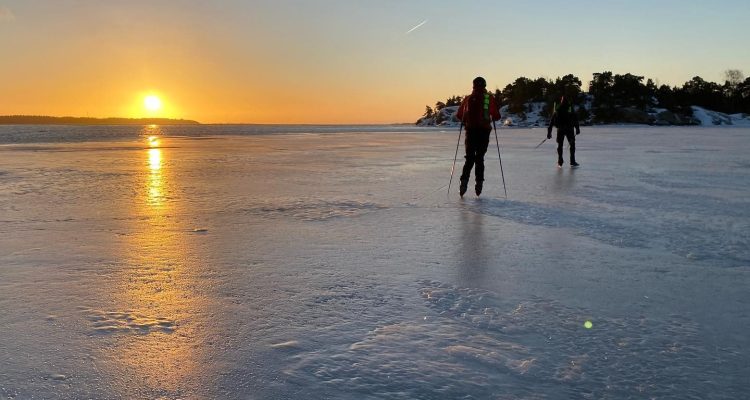Best Way to Walking on Ice: Expert Tips for Safe Navigation
To walk safely on ice, wear ice grippers on your shoes for better traction and take slow, deliberate steps to avoid slipping. Walking on ice can be hazardous, but with the right precautions and techniques, you can navigate icy surfaces confidently and prevent accidents.
Ice grippers, also known as ice cleats, can provide extra stability by gripping the ice and preventing slips. By walking slowly and consciously placing your feet flat on the ground, you can distribute your weight evenly and maintain balance. Additionally, using a walking stick or holding onto handrails can further support your stability while walking on ice.
Keep these tips in mind to stay safe and steady while walking on icy terrains.
Choose The Right Footwear
When it comes to walking on ice, choosing the right footwear is crucial. Investing in the right pair of boots can provide the much-needed traction and stability to keep you safe and secure. Let’s take a look at two key factors to consider while selecting ice-walking footwear: insulated and waterproof boots, and boots with gripping soles.
Insulated And Waterproof Boots
Insulated and waterproof boots are essential for walking on ice. Insulation helps to keep your feet warm, preventing the discomfort of freezing toes. Additionally, waterproof boots provide a protective barrier, keeping your feet dry even in wet conditions. This is especially important on icy surfaces, as wet feet can quickly lead to discomfort and, in extreme cases, frostbite. Investing in boots that offer both insulation and waterproof properties is a smart choice for your ice-walking adventures.
Gripping Soles
Equally important are boots with gripping soles. The soles of your boots come into direct contact with the icy ground, and having a good grip is crucial to maintain balance and prevent slipping or sliding. Look for boots with rubber or thermoplastic soles that offer excellent traction. These materials are designed to provide a strong grip on icy surfaces, reducing the risk of accidents and falls. Boots with deeper treads or lugs can provide even better traction by increasing the grip on slippery terrain. When shopping for ice-walking boots, pay close attention to the soles to ensure they offer the necessary grip for a safe and confident stride.

Credit: www.oregonlive.com
Walk With Caution
Slow And Steady
Take slow steps to maintain balance on icy surfaces.
Shorten Your Stride
Reduce your stride length for better stability and control.
Use Proper Walking Techniques
Discover the best way to walk on ice with proper techniques that ensure safety and stability. Learn how to navigate icy surfaces effectively, reduce the risk of slipping, and maintain balance during winter walks.
Use Proper Walking Techniques When walking on ice, it is crucial to use proper walking techniques to minimize the risk of slipping and falling. Implementing the following walking techniques can significantly improve stability and reduce the likelihood of accidents. Bend Your Knees Bending your knees while walking on ice helps to lower your center of gravity, improving stability and balance. By maintaining a slight bend in your knees, you can react more effectively to any unexpected slips or uneven patches on the ice. Walk Flat-Footed Walking flat-footed on ice helps to distribute your body weight more evenly, providing better traction and stability. Instead of walking on tiptoes, keep your feet flat and parallel to the ground to increase surface contact and minimize the risk of slipping. By incorporating these proper walking techniques, you can enhance your safety and reduce the likelihood of slipping while walking on ice.
Credit: www.silive.com
Additional Safety Measures
Discover the best way to navigate icy conditions with added safety measures. Improve traction by wearing slip-resistant footwear and walking with small, deliberate steps. Consider using ice cleats for extra grip and stability to prevent slipping.
Use Ice Spikes Or Crampons
When it comes to walking on ice, it’s crucial to consider additional safety measures. One such measure is using ice spikes or crampons on your footwear. These handy attachments can provide you with the extra grip and stability needed to prevent slips and falls on icy surfaces. Designed specifically for icy conditions, ice spikes and crampons feature sharp metal spikes or teeth that dig into the ice, offering you improved traction and minimizing the risk of accidents. So, make sure to equip yourself with these safety accessories before venturing out onto icy terrains.
Walk In Designated Areas
Another important safety measure to bear in mind is to always walk in designated areas. These areas are usually marked and maintained to ensure maximum safety for pedestrians. By sticking to designated paths and walkways, you are minimizing the chances of encountering hidden hazards or uneven surfaces that may increase the risk of accidents. Additionally, walking in designated areas also helps preserve the integrity of natural environments, as it prevents unnecessary trampling and damage to sensitive ecosystems. So, be sure to follow the signs and stay on marked paths when walking on icy surfaces.

Credit: www.silive.com
Frequently Asked Questions Of Best Way To Walking On Ice
What Is The Trick To Walking On Ice?
To walk safely on ice, wear traction-boosting footwear and take small steps with your feet pointing slightly outwards. Keep your center of gravity over your front foot and use your arms for balance. Avoid sudden movements and walk slowly to maintain stability.
How Do You Walk On Ice And Snow Without Slipping?
To walk on ice and snow without slipping, wear proper footwear with good traction. Take small steps and walk flat-footed. Keep your knees slightly bent for balance. Use products like ice grips or traction cleats for extra grip. Avoid icy patches and walk on snow instead.
How Do You Walk Safely On Icy Paths?
To walk safely on icy paths, follow these guidelines: 1. Wear non-slip footwear for better traction. 2. Take short and slow steps to maintain stability. 3. Use handrails or walls for support when available. 4. Watch for shady areas where ice may be present.
5. Avoid distractions and stay alert to potential hazards.
How Do You Keep From Slipping On Ice?
To prevent slipping on ice, wear slip-resistant shoes, walk slowly, take small steps, use handrails, and sprinkle salt or sand for added traction.
Conclusion
Walking on ice safely requires mindfulness and proper footwear. Remember to take slow, deliberate steps to prevent slipping. Utilize ice cleats for added traction during icy conditions. Stay vigilant and adjust your stride to maintain stability. By following these tips, you can confidently navigate icy surfaces with ease.





